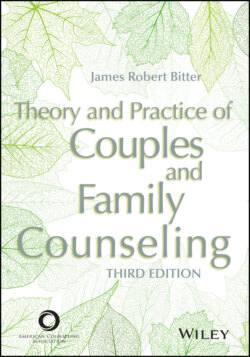Читать книгу Theory and Practice of Couples and Family Counseling - James Robert Bitter - Страница 54
Solution-Focused/Solution-Oriented Models
ОглавлениеThe bridge between the era of structural-strategic family processes and postmodern approaches to family counseling starts with the work of Steve de Shazer and his partner Insoo Kim Berg. John Weakland had introduced Steve to Insoo when Steve was studying at MRI. In 1978, Steve and Insoo moved to Milwaukee, Wisconsin, with the intent of reinventing MRI in the Midwest. Initially they joined with colleagues at a community mental health agency in Milwaukee in an effort to achieve this goal, but when the constraints of that agency got in the way, they left to start their own Brief Family Therapy Center. They took a number of colleagues with them, including Jim Derks and Eve Lipchik, and the center opened in 1979. The center had a training program that attracted students who would become second-generation leaders of solution-focused therapy: Michele Weiner-Davis, Yvonne Dolan, Scott Miller, John Walter, and Jane Peller.
Over the years, de Shazer (1982, 1985, 1988, 1991) focused more on the development of the model and its underlying theory while Berg developed training and focused her work on the practical application of the model to the most pressing family problems. Originally influenced by John Weakland and the MRI approach as well as the writings of Milton Erickson, de Shazer began to question some of MRI’s assumptions and positions: (a) MRI focused on the problem and how it was being maintained, believing that a shift in family perspective would unleash new possibilities for solving the problem. de Shazer turned this notion around, believing that focusing on the negative language of the problem actually held change back. A focus on solutions was a focus on positive languaging, on possibilities, on the future, and on hope. (b) MRI assumed a one-down position in initial therapeutic practice, but it did not give up the notion that the therapist knew what needed to happen for the family and its members. de Shazer came to believe, like most postmodern therapists, that the person and the family was an expert on what was needed, both in terms of change and help. In practical terms, this meant that counseling moved from giving directives (as in the MRI model) to asking questions. (c) MRI therapists handled resistance indirectly, using paradox and other Ericksonian interventions. With a focus on individual- or family-developed solutions, de Shazer declared the end to resistance. He truly believed that people wanted to change, and given a clear goal they would move toward it.
The techniques developed in this model of assessment are some of the most innovative in the field. They include the Miracle Question, scaling questions, exceptions, coping questions, and compliments. These interventions make possible the construction of solutions from the life experiences of the person or the family (de Shazer & Berg, 1993). Insoo Kim Berg would team up with Scott Miller to apply solution-focused therapy to the treatment of alcoholism—and by extension to other forms of substance abuse (Berg & Miller, 1992). Her work also focused on couples counseling and family counseling with the poor. Eve Lipchik (2002) too was involved in the development of the model from the beginning, and her focus on emotions and the therapeutic relationship is one of the more significant contributions to the model.
From their base in Chicago, John Walter and Jane Peller (1992, 2000) focused on exception questions and wrote two of the more compelling process books for solution-focused therapy. Similarly, Yvonne Dolan, a leader of the Solution-Focused Brief Therapy Association, worked closely with Steve de Shazer over the years; applied the model to those who had experienced trauma or abuse; and coauthored Steve’s last book, which was published posthumously (de Shazer & Dolan, 2007).
Perhaps one of the best known students of this model is Michele Weiner-Davis, who has published very popular books on couples counseling as well as more scholarly efforts. Michele teamed up with Bill O’Hanlon to create solution-orient- ed therapy, a hybrid model that did not completely eschew talking about problems (W. H. O’Hanlon & Weiner-Davis, 2003). For a while in the late 1990s and early 2000s, these two approaches to solution work coexisted, with O’Hanlon, who never directly worked out of the Milwaukee center, becoming a major spokesman for solution work. O’Hanlon and Weiner-Davis would eventually split too, with Bill moving to New Mexico and calling his work possibility therapy.
Steve de Shazer died in 2005. Two years later in 2007, Insoo Kim Berg also died.
